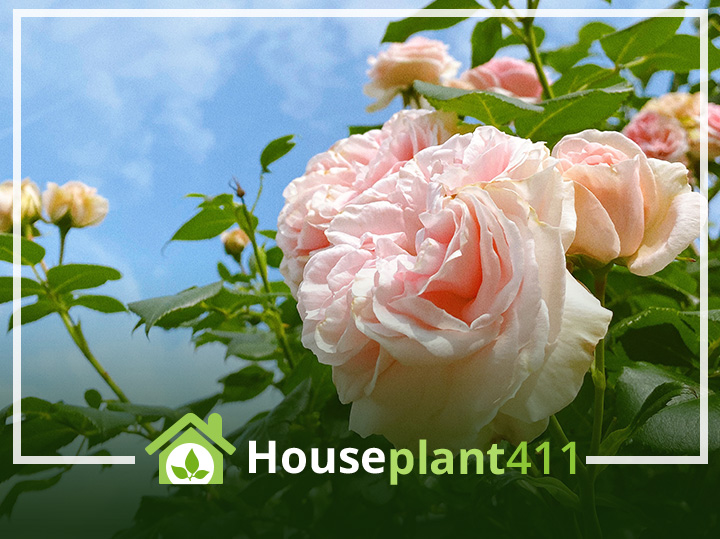Miniature Rose bush plants, beautiful little hybrid plants that trace their parents back to China, usually appear in stores around Valentine’s Day and Mother’s Day. These indoor houseplant rose bushes look lovely when first purchased but are difficult to keep indoors on a permanent basis. Enjoy your rose bush plant in your home and then plant it outside as soon as the weather permits. A miniature rose bush plant grows much better outdoors in the fresh air and bright light. This plant produces small 1”-2” (2.5-5cm) flowers in red, yellow, pink, white, peach, and orange. Since a miniature rose is a hybrid of the regular rose, it requires the same type of care and attention as a regular Rose Bush plant.
Plant Care
Light
A miniature rose bush plant needs very bright light. If you don’t have a place in your home where the plant can get several hours of direct sun, move the rose bush outdoors into the sun for a few hours each day once the danger of a frost is over. When there is not enough light, rose bushes don’t bloom, the stems start to stretch to the light, and leaves are far apart.
Water
A miniature rose bush requires a great deal of water, especially when it is flowering. Since these plants are usually purchased in small pots, be sure to check the soil every few days. Allow the top 1” (2.5cm) of soil to dry out before watering. During the winter, when a miniature rose bush plant is resting, keep the soil barely moist. Be careful not to get water on the leaves; wet leaves often cause a fungus called Black Spot to develop.
Fertilizer
Feed every two weeks in the spring and summer when the plant is actively growing. Use a fertilizer that is high in phosphorous (5-10-5) at ½ the recommended strength.
Temperature
Miniature rose bush plants do well in temperatures between 60°-75°F (16°-24°C). These plants are very susceptible to frost damage.
Humidity
Moderate to high humidity helps the plant to grow well. If your home is dry, especially in the winter, place a miniature r bush plant on a tray of wet pebbles. Be sure the plant is sitting on the pebbles and not in the water.
Flowering
Remove dead blooms as soon as they appear; this helps the plant bloom for a longer period of time. Always use a sharp pruner or scissors to cut off the flowers, never just pull them off with your fingers. Tearing the stems of a miniature rose bush, rather than cutting them at a 45° angle, damages the stem and encourages diseases. Once the plant finishes blooming and the weather warms up, move it outdoors, but be sure to bring it back inside once the temperature goes below freezing.
Pests
Spider mites and mealy bugs are two houseplant pests that can infest an indoor rose bush. Rinse the leaves once a week with a mild, soapy, water solution to help prevent infestations and keep the plant dust-free.
Diseases
If the soil is kept too damp, miniature rose bush plants, like their bigger outdoor cousins, develop a fungal plant disease called black spot. Immediately remove the infected leaves and treat the plant with a fungicide recommended for black spot disease.
Pot Size
If there is more than one plant in your pot, remove the plants from the container, gently separate the roots of the two plants, and replant them into their own pots. Use as much of the original soil as possible and be sure all pots have proper drainage holes. When the pot of a miniature rose bush plant is too large, the plant doesn’t grow and root rot develops.
Pruning
Remove dead branches and any other branches that may be rubbing against each other. Once the plant has finished blooming in the fall, prune the rose bush to encourage new growth during the next season.
Propagation
You can propagate using stem tip cuttings in the early summer. Use a 4” (10cm) piece of a healthy stem, dip the cut end in rooting hormone, and plant it in a small pot of moist potting soil. Set the plant in a clear plastic bag to increase the humidity while it is rooting.
Poisonous Plant Info
Miniature rose bush plants are non-poisonous plants.
FAQ
The flowers buds on your miniature rose bush plant shrivel and die before opening because the air in your home is probably too dry. These plants really prefer high humidity. Place your plant on a tray of wet pebbles (be sure the plant is sitting on the pebbles and not in the water) or next to a humidifier to increase the humidity around it.
It sounds like your miniature rose bush plant needs much more very bright light. An indoor rose bush quickly deteriorates when it is not getting enough light. Miniature Rose plants like be planted outside in the sun as soon as the weather permits.
Your miniature rose bush plant has a plant fungus called black spot disease and washing the leaves just makes it worse. Remove the infected leaves, keep the rest of the leaves dry, decrease the humidity if possible, and spray your the plant with a Fungicide made for black spot disease.
Miniature rose bush plants get yellow leaves for any number of reasons: not enough water, not enough sun, or not enough humidity. Also, miniature rose bushes, like regular roses, become dormant for a few months and it is natural for them to lose their leaves during this period.

